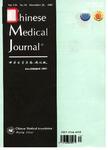Gene-viral vectors: a promising way to target tumor cells and express anticancer genes simultaneously
肿瘤靶向且高效表达抗癌基因的基因 病毒载体系统(英文)作者机构:第二军医大学东方肝胆外科医院病毒和基因治疗中心上海200438 LaboratoryofCancerGeneTherapy
出 版 物:《Chinese Medical Journal》 (中华医学杂志(英文版))
年 卷 期:2002年第115卷第8期
页 面:1213-1217,154-155页
核心收录:
学科分类:1002[医学-临床医学] 100214[医学-肿瘤学] 10[医学]
主 题:Adenoviridae Adenovirus E1A Proteins Adenovirus E1B Proteins Gene Therapy Genetic Vectors Humans Interleukin-12 Neoplasms Recombination, Genetic Research Support, Non-U.S. Gov't Tumor Cells, Cultured Virus Replication
摘 要:OBJECTIVE: To develop a new kind of vector system called gene-viral vector, which combines the advantages of gene and virus therapies. METHODS: Using recombinant technology, an anti-tumor gene was inserted into the genome of replicative virus specific for tumor cells. The cell killing effect, reporter gene expression of the green fluorescence protein, anti-tumor gene expression of mouse interleukin-12 (mIL-12) and replication of virus were observed by the methods of cell pathology, fluorescence microscopy, ELISA and electron microscopy, respectively. RESULTS: A new kind of gene-viral vector system of adenovirus, in which the E1b-55 kD gene was deleted but the E1a gene was preserved, was constructed. The vector system, like the replicative virus ONYX-015, replicated and proliferated in tumor cells but not in normal ones. Our vector had an advantage over ONYX-015 in that it carried different kinds of anti-tumor genes to enhance its therapeutic effect. The reporter gene expression of the green fluorescence protein in tumor cells was much better than the adenovirus vector employed in conventional gene the rapy, and the expression in our vector system was as low as or even less than that in the conventional adenovirus gene therapy system. Similar results were observed in experiments with this vector system carrying the anti-tumor gene mIL-12. Replication and proliferation of the virus carrying the mIL-12 gene in tumor cells were confirmed by electron microscopy. CONCLUSIONS: Gene-viral vectors are new vectors with an anti-tumor gene inserted into the genome of replicative virus specific for tumor cells. Because of the specific replication and proliferation of the virus in tumor cells, expression of the anti-tumor gene is increased hundreds to thousands of times. This approach takes full advantages of gene therapy and virus therapy to enhance the effect on the tumor. It overcomes the disadvantages of conventional gene therapy, such as low transfer rate, low gene expressio



